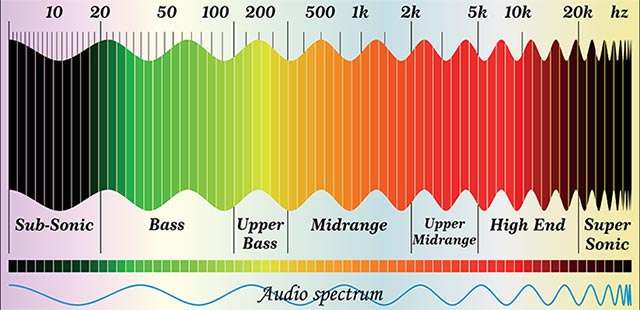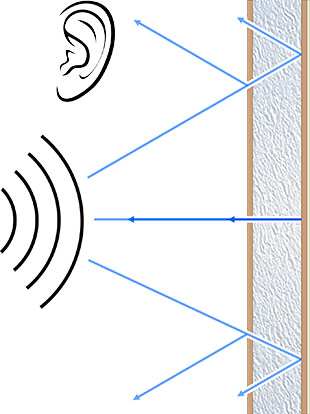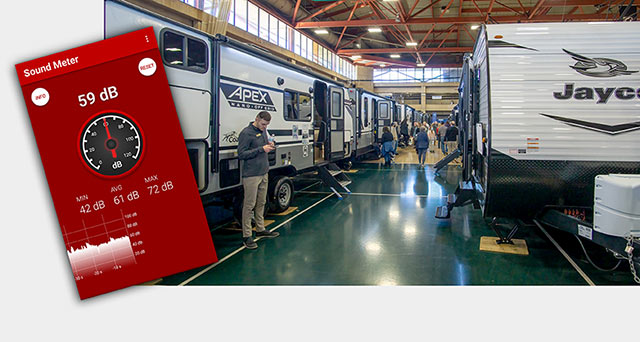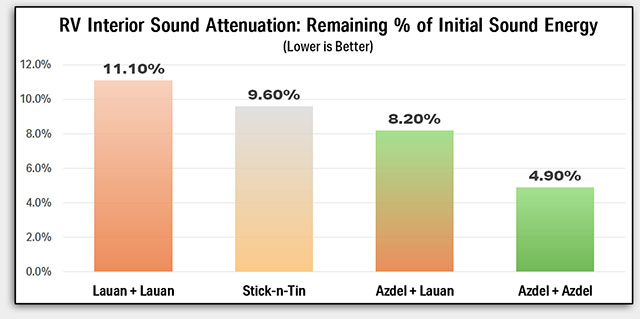
Sound Absorption
While Azdel Onboard® composite was not designed for sound absorption like the foam panels above, it does a darn good job
Understanding Sound and Frequency
Before we dig into the test results, let’s review sound and sound frequency so we have a better understanding what the results mean.
As vibrations, usually from contact or friction, propagate as acoustic waves and are transmitted through a medium, sound is created. The medium could be a gas (air), solid or liquid. Human hearing is the reception and perception of that sound.
Though the audio frequency spectrum is much broader, humans with normal hearing can generally detect sounds between 20 and 20,000 (20K) hertz. Hertz (Hz) is the unit of measure for frequency, equivalent to one wave or cycle per second. As the frequency decreases, the sound pitch gets lower, and vice versa.
Human speech and other common sounds tend to be in the range of 250-8,000Hz.

Sound Absorption Test: Azdel vs Lauan – No Contest
Using separate and typical wall samples constructed with Azdel Onboard composite and lauan respectively, this test measured absorption levels for both wall types at multiple frequencies in the mid-to-high range using random sounds generated inside an RV. Conducted by an accredited sound lab, the test reveals a dramatic contrast in absorption levels between the wall types, particularly in higher frequencies. As noted above, human speech and common noises are typically in the 250-8,000 Hz range. The upper half of this range is where the performance of the walls truly diverge.

Noise depicted inside RV against sidewall with Azdel

Random Incidence Sound Absorption Coefficients in a Small Reverberation Room (SAE J2883)

Noise depicted inside RV against sidewall with lauan
The lauan wall averaged only 9% absorption and peaked at only 18%. Conversely, walls constructed with Azdel had an average of 41% sound absorption with a peak of 88%. This is largely due the nature of our porous and fibrous material. Some of the sound waves get trapped inside the core, bouncing among the fibers, ultimately getting absorbed or dissipating. The trapping of soundwaves is much like the trapping of air in the porous core, which leads to a higher R-value for our composite. Ultimately, the benefit for the RV owner is a significantly quieter interior, and a far more peaceful and relaxing RVing experience.
RV Interior Decibel (dB) Attenuation
This test was a bit different. This took place at a live RV show so we could use some natural noise and real world conditions.
At each RV, we measured the ambient exterior decibel level of the show noise, then entered the RV and ran a similar test inside, taking an average of multiple rooms where applicable. We then calculated the difference between the exterior dB level measured from the outside, and that measured from the inside. This resulted in a dB decrease or attenuation of some level.
We grouped the range of RVs by wall construction and then calculated averages based on each of the four groups. Read on for more information and the test results.

Relationship of Decibles (dB) to Sound Energy

Let’s try to understand decibels a little better. A dB is the unit of measurement for sound energy. It is not based on a linear scale, but rather a logarithmic scale. This makes comparing sound levels much more difficult.
If a noise increases from 60-63 dB, it is not simply 5% louder, it is twice as loud, or 200% louder. Or if a noise drops from 80dB to 70dB, its sound energy is only one-tenth, or 10%, of what it was.
With this knowledge, we used a tool designed to calculate the percent of sound energy remaining after a change in dB level. The final results are revealed in a graph.
Azdel Steals the Show Again

As expected, all of the units experienced a drop in exterior noise from inside.
Those with lauan on both sides of the walls saw the smallest decrease. They averaged just under a 10dB drop, which reduced the original noise to just over 11% of what it was. Stick-n-Tin was a little better, largely due to the sound-absorbing batt insulation in the walls.
The Azdel/Lauan combination was better still, but the walls using Azdel composite on both sides performed far better in this test. These units dropped over 13dB, leaving less than 5% of the original exterior noise. This helps explain why we often hear that “Azdel walls are quieter”.